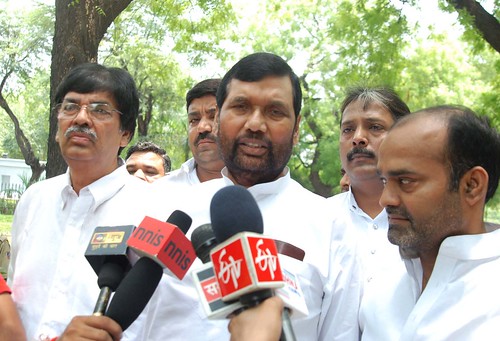By Soroor Ahmed, TwoCircles.net,
In election rallies in Bihar recently Narendra Modi would often be seen flanked by two Dalit leaders–– Ram Vilas Paswan and Jitan Ram Manjhi. In his speeches the prime minister would repeatedly attack Nitish Kumar for humiliating, insulting and subsequently sacking a Dalit chief minister. The BJP left no stone unturned to woo the community.
After the electoral debacle and swearing-in of the new Kumar government, the Dalits of the state are now left with no towering leader. Not only Paswan and Manjhi got marginalized, even senior Dalit ministers of the last cabinet Ramai Ram and Shyam Rajak as well as former speaker Uday Narayan Chaudhary lost their positions.

Ram Vilas Paswan (File Photo)
While Ram and Chaudhary could not find place as they lost election Rajak was a surprise omission though he won.
But it is the rout of Paswan and Manjhi, which is attracting more media attention as the castes to which they belong form two opposite poles of Dalits of the state?
While Dussadhs, the caste to which LJP leader belongs, is economically and socially strongest the Manjhi’s Musahars are the weakest among 22 Scheduled Castes. They both are numerically strong and form almost half of the 15.72 per cent SCs’ population. Though both are in NDA yet during the election the two worked to cancel out each other’s influence so that one of them could emerge as the tallest leader of the SCs. Thus the LJP and HAM ended up with just two and one seats out of 42 and 21 they contested.
The lone HAM candidate to win is Manjhi himself. Ironically, he defeated Chaudhary.
Unlike Paswan and Manjhi, the problem with Ram, Chaudhary and Rajak is that the castes to which they belong are politically not as significant in Bihar. Ram hails from Ravidas community, which is numerically strong in Bihar, but is no match to their presence in UP, where they form almost two-thirds of 21.15 per cent Dalit population. Chaudhary is a Pasi (toddy-seller) while Rajak a Dhobhi (washerman). Both these castes are numerically not very strong. This deprives them of the opportunity to emerge as the most influential leader of Dalits.
Manjhi was never a known Dalit leader till May 20, 2014, when Nitish decided to resign and hand-picked him for the post of chief minister. More than the post, Nitish inadvertently gave the Dalit leader a voice. Perhaps he used his voice less to champion the cause of his community, and more to promote his own political ambition. He joined hands with the BJP thinking that Nitish’s era is over. The move backfired.
Paswan is among the oldest Dalit politician of India. He jumped into electoral politics way back in 1969. After Jagjiwan Ram’s death in 1986 he was the tallest Dalit leader left in north India. Kanshi Ram and Mayawati entered the electoral politics more than 15 years after him.
Not to speak of emerging as Dalit leader of India, Paswan could not even be the leader of SCs of his own state. The polling percentage of LJP fell from 6.4 per cent in the 2014 Lok Sabha poll to just 4.8 per cent this time. HAM could win only 2.3 per cent votes.
With estimated nine per cent and 13-14 per cent Yadav votes Mulayam Singh Yadv and Lalu can emerge as strong caste leaders of UP and Bihar respectively, but Paswan with more SCs’ population could not.
True in UP the population of SCs is higher than Bihar. But one should not ignore the fact that both Kanshi Ram and Mayawati were from Punjab and Delhi respectively who entered the state politics much later. Yet within a decade they were powerful force.
In the worst case scenario––with no seat in Lok Sabha––the BSP alone managed to secure 19.82 per cent votes. With some efforts Mayawati can once again be a force to reckon with.
Soroor Ahmed is a Patna-based freelance journalist. He writes on political, social, national and international issues.

